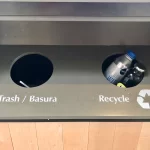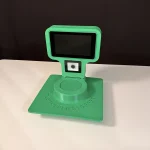The global push for sustainability has elevated recycling from a good practice to an environmental necessity. Yet, despite best intentions, recycling contamination taking place at the bin level of the recycling stream remains one of the biggest challenges in achieving a clean, efficient, and profitable recycling system. Contamination not only disrupts the recycling process but also drives up costs, reduces the quality of recyclable materials, and results in more waste ending up in landfills. Let’s consider the problems caused by contamination, what companies and consumers can do to prevent it, and highlight Waste Wise Innovation’s Topper Stopper™ smart recycling bin technology, designed to tackle recycling contamination head-on.
The Problems Caused by Contamination in Recycling Streams
Recycling contamination occurs when non-recyclable items or improperly prepared recyclables are mixed into recycling bins. This seemingly small mistake can create a ripple effect of negative consequences throughout the entire recycling process:
- Reduced Efficiency: Contamination requires recycling facilities to spend more time and resources sorting materials. For example, a single plastic bag or food-soiled container can slow down sorting machines or force manual removal, leading to inefficiencies that drive up operational costs.
- Damaged Equipment: Items like plastic bags, wires, or even electronics can get caught in recycling machinery, causing breakdowns and costly repairs. These disruptions can halt operations and decrease productivity at material recovery facilities (MRFs).
- Lower Quality of Recycled Materials: Contaminated materials degrade the quality of recyclables. For instance, greasy paper products or wet cardboard can make entire batches unsuitable for reuse, forcing recycling facilities to discard large quantities of materials.
- Increased Waste to Landfills: When contamination levels are too high, recyclables that could otherwise be processed are sent to landfills. This undermines the goal of reducing waste and lowers overall recycling rates.
- Higher Costs for Recycling Programs: Contamination increases processing costs, which are often passed down to municipalities and consumers. In some areas, high contamination rates have even led to recycling programs being scaled back or discontinued.
How Companies and Consumers Can Prevent Recycling Contamination
While recycling contamination is a significant problem, both companies and consumers can take concrete steps to prevent it:
What Companies Can Do:
- Employee Training and Awareness: Companies should educate employees on what can and cannot be recycled, along with proper recycling procedures. Regular training sessions and clear communication through posters, emails, or workshops can make a significant difference.
- Clear Labeling and Signage: Ensure that recycling bins are clearly labeled with instructions and examples of acceptable materials. Color-coded bins and visual prompts can help eliminate confusion and improve compliance.
- Streamline Recycling Processes: Make recycling simple for employees or customers by placing bins in easily accessible areas and clearly marking them to reduce the chances of cross-contamination.
- Regular Audits and Feedback: Companies can periodically audit their recycling streams to identify common contamination sources and offer targeted feedback to employees or departments.
- Partner with Waste Management Services: Collaborating with recycling contractors or waste management providers can offer companies additional guidance on how to handle and reduce contamination.
What Consumers Can Do:
- Learn Local Recycling Guidelines: Understanding what items are accepted in your local recycling program is crucial. Don’t engage in “wish-cycling,” where you toss questionable items into the bin in hopes they’ll be recycled. This often leads to contamination.
- Clean and Dry Recyclables: Rinse out containers, remove food residue, and dry recyclables before tossing them in the bin. Even a small amount of grease or food can contaminate entire batches of recyclables, especially paper and cardboard.
- Separate Different Materials: Many items, such as bottles and caps or mixed-material packaging, need to be separated to ensure proper recycling. Taking a few seconds to disassemble these items goes a long way.
- Avoid Plastic Bags: Plastic bags are one of the most common contaminants in recycling streams. Instead of tossing them in curbside bins, take them to designated recycling drop-offs at grocery stores or reuse them for household purposes.
- Compost Food Waste: Food scraps should never go in the recycling bin. Composting organic waste is a much better solution and helps keep recyclables clean.
Smart Recycling Bin Technology: The Topper Stopper™ by Waste Wise Innovation
One of the most promising technologies for eliminating contamination in recycling streams is smart recycling bin technology. Waste Wise Innovation’s Topper Stopper™ is a cutting-edge solution designed to reduce contamination at the source by providing users with real-time feedback on their recycling habits.
How the Topper Stopper™ Works:
The Topper Stopper™ is equipped with smart sensors, data evaluation, and contamination prevention technology that detect the types of materials being placed in the recycling bin. If an item is deemed non-recyclable, the unit will notify the user through visual cues and prevent the access door from opening, ensuring only the correct recyclable materials make it into the recycling stream.
Key Benefits of the Topper Stopper™:
- Real-Time Feedback: The Topper Stopper™ educates users in the moment, preventing contamination by guiding them on what is acceptable for recycling.
- Increased Recycling Accuracy: By eliminating common contaminants like plastic bags, food waste, and hazardous materials, the Topper Stopper™ ensures cleaner, more efficient recycling streams.
- Data and Insights: The system collects data on recycling habits, allowing companies or municipalities to track contamination levels, identify problem areas, and adjust educational efforts accordingly.
- Reduced Costs: With less contamination, recycling facilities can process materials more efficiently, lowering operational costs and improving the quality of recyclable outputs.
- Reduced Barrier to Entry: The Topper Stopper™ units retrofit to many existing recycling bins and have a per unit cost that is much lower than other smart bin technology.
- Consumer Engagement: The Topper Stopper units are equipped with screens that can present sustainability messaging as well as generate interest by consumers using competitions, rewards, or other programs.
- Environmental Impact: Cleaner recycling streams mean more materials can be properly processed and reused, reducing the amount of waste that ends up in landfills and conserving natural resources.
Conclusion
Contamination in the recycling stream presents significant challenges, from increased costs to reduced recycling efficiency and environmental harm. However, both companies and consumers can take meaningful steps to minimize contamination by educating themselves, improving processes, and adopting new technologies like the Topper Stopper. By doing so, we can ensure that our recycling systems work effectively, creating a cleaner, more sustainable future for everyone.






